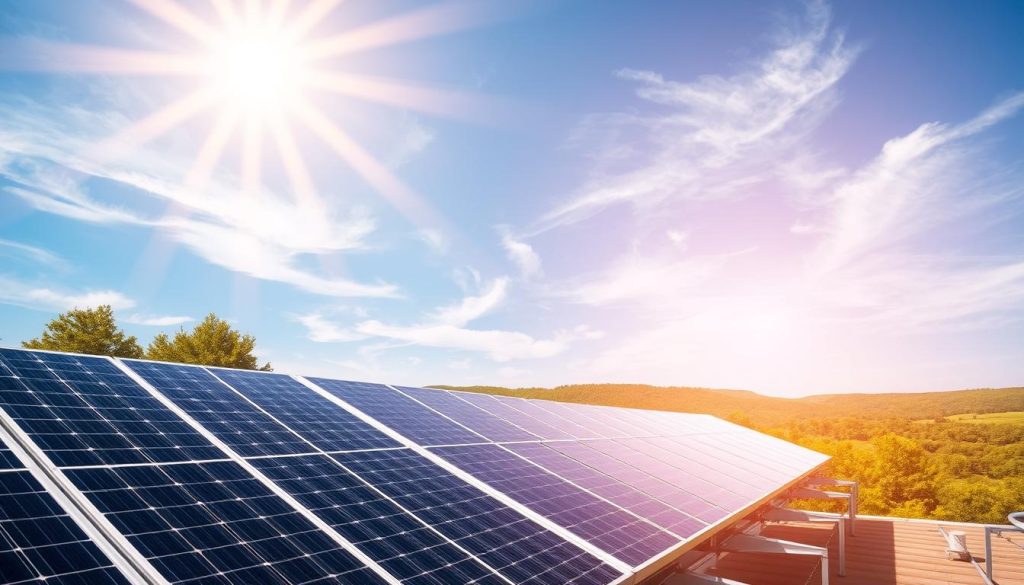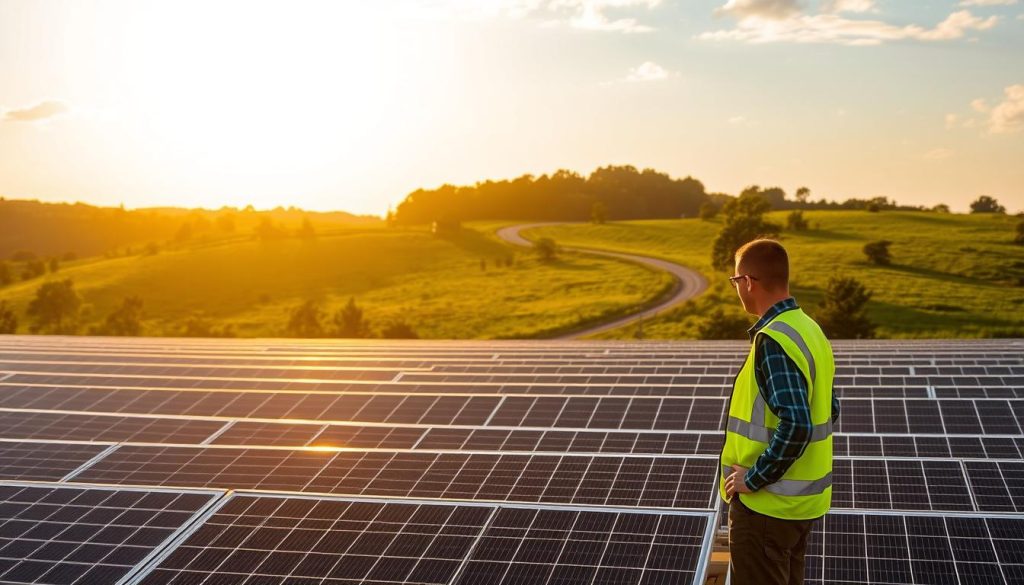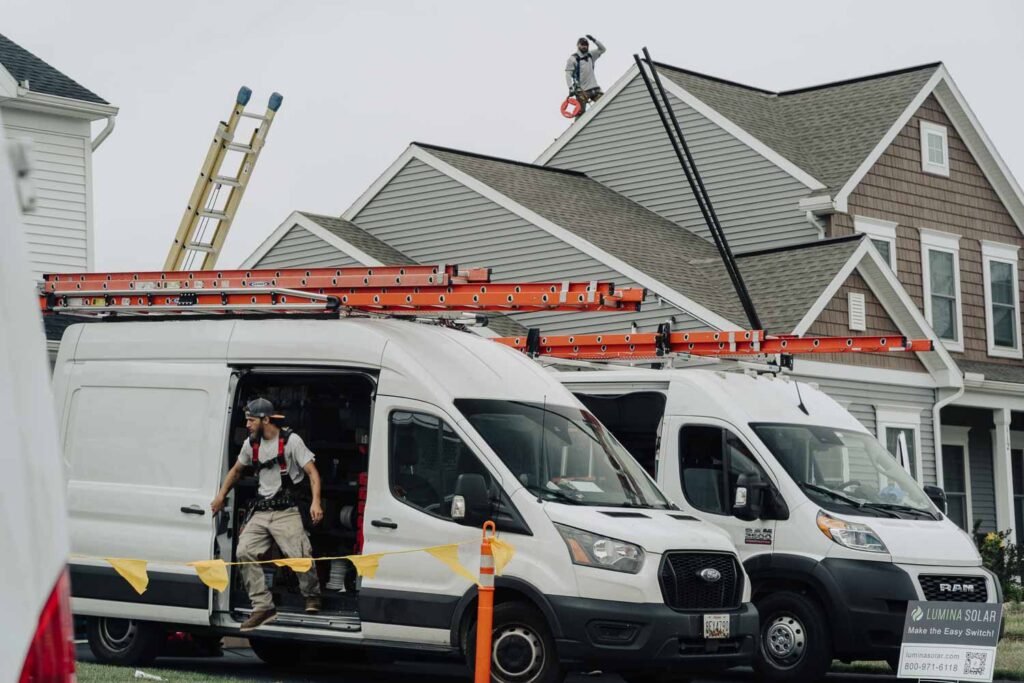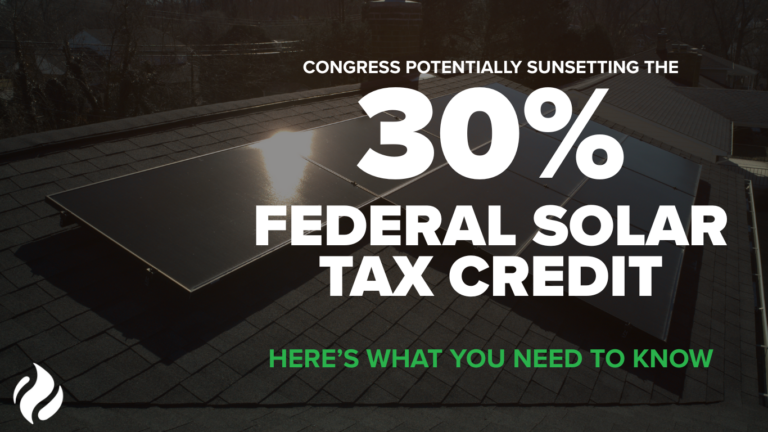Harnessing Solar Energy in Pennsylvania
Have you ever felt a deep responsibility to preserve our environment for future generations? This sense of duty is inspiring significant changes in Pennsylvania’s approach to energy production.
For more information – Click Here
Pennsylvania is making strides in renewable energy, with solar technology leading the charge. The state ranks 22nd in national capacity, showcasing its growing commitment to clean energy solutions. From residential rooftops to large-scale projects, solar panels are transforming how we think about energy.

Investing in solar energy not only reduces your energy bills but also supports a sustainable future. Companies across the state are driving this change, offering innovative solutions for homes and businesses. Projects like Whitetail Solar and Elk Hill Solar highlight the impressive scale of installations in Pennsylvania.
With local policies encouraging adoption and financial incentives available, now is the perfect time to explore solar options. Whether you’re a homeowner or a business owner, transitioning to renewable energy has never been more accessible. Join the movement and discover how solar can benefit you and the environment.
Introduction to Solar Energy in Pennsylvania
Harnessing renewable energy is becoming a priority for many Pennsylvania homeowners. With rising energy costs and a growing focus on sustainability, more people are turning to solar solutions. This shift not only helps reduce monthly bills but also contributes to a cleaner environment.
Modern solar systems are designed to be efficient and adaptable. Whether your home has a large roof or limited space, there’s a solution for you. The installation process is straightforward, and professionals ensure your system is tailored to your energy needs.

Pennsylvania’s policies are also evolving to support this transition. Programs like net metering allow homeowners to earn credits for excess energy produced. These incentives make it easier than ever to invest in a solar system for your home.
By adopting renewable energy, you’re not just saving money—you’re making a positive impact on the state’s energy future. The benefits are clear: lower costs, environmental sustainability, and energy independence. Start exploring your options today and join the growing movement toward cleaner energy.
Policy and Market Insights for Solar in PA
Pennsylvania’s renewable energy landscape is evolving rapidly, with strong policy support driving adoption. State-level incentive programs are designed to accelerate installations and reduce upfront costs. These initiatives make it easier for homeowners and businesses to transition to clean energy.
One key program is the Solar Renewable Energy Credit (SREC) system. This allows you to earn credits for the energy your system generates. The value of these credits fluctuates based on market demand, providing a financial boost to your investment.
Federal tax credits also play a significant role. The Solar Investment Tax Credit (ITC) lets you deduct 30% of installation costs from your federal taxes. Combined with state incentives, this makes renewable energy more affordable than ever.
Recent legislative measures, like the proposed amendment to the Alternative Energy Portfolio Standards (AEPS), aim to increase the state’s renewable energy goal to 5.5%. If passed, this could create 100,000 jobs by 2030, further boosting the local economy.
Market insights show that Pennsylvania’s solar capacity grew from 495 MW in 2019 to 761 MW in 2020. This growth is fueled by supportive policies and the increasing competitiveness of renewable energy. Programs like net metering allow you to sell excess energy back to the grid, maximizing your savings.
By taking advantage of these programs and incentives, you can significantly reduce your energy costs while contributing to a cleaner future. Pennsylvania’s commitment to renewable energy ensures that now is the perfect time to make the switch.
Solar Power PA
The demand for clean energy solutions is reshaping Pennsylvania’s utility landscape. With rising adoption rates, the state is becoming a hub for innovative renewable energy projects. From residential rooftops to large-scale farms, the shift is undeniable.
Utilities are adapting to this change by integrating more renewable sources into their grids. Companies are also offering tailored solutions to meet diverse energy needs. This ensures that every home or business can benefit from clean energy.
Investing in renewable energy is now more accessible than ever. With competitive pricing and attractive rates, the upfront costs are offset by long-term savings. Programs like net metering allow you to earn credits for excess electricity generated.
Choosing the right installer is crucial for maximizing your investment. Experienced professionals ensure your system is efficient and tailored to your needs. This not only enhances performance but also extends the lifespan of your setup.
Pennsylvania’s renewable energy market is thriving, with projects like the 72 MWdc initiative in Franklin County leading the way. These efforts highlight the state’s commitment to a sustainable future. By joining this movement, you can contribute to a cleaner, greener Pennsylvania.
Step-by-Step Guide for Solar Installation
Switching to renewable energy starts with a clear plan and the right steps. The process begins with assessing your home’s energy efficiency and potential for renewable energy. A professional evaluation will determine if your property is suitable for installation.
Next, you’ll need to select a qualified installer. Look for verified registration and certifications from local authorities. This ensures your system is installed safely and efficiently. A reliable installer will also provide detailed information about the process and costs.
Once you’ve chosen an installer, it’s time to prepare a robust plan. This includes installation, interconnection, and system activation. Discuss options like battery backup solutions to enhance your system’s reliability.
Financing is a critical part of going solar. Explore federal and state tax credits, rebates, and incentives to reduce upfront costs. Your installer can guide you through these options, ensuring you maximize your savings.
Finally, the installation process typically takes one to three days. After activation, you’ll start generating clean energy and saving on your bills. Regular maintenance ensures your system operates at peak efficiency for years to come.
By following these steps, you can make a smooth transition to renewable energy. Start today and take control of your energy future.
Navigating Solar Incentives and Financial Support
Exploring financial incentives can make your transition to clean energy more affordable and rewarding. With programs designed to reduce upfront costs, you can save money while contributing to a sustainable future. Federal and state tax credits are among the most impactful options available.
The federal Solar Investment Tax Credit (ITC) offers a 30% deduction on installation costs. This incentive applies to systems installed between 2022 and 2032, making it a significant option for reducing your initial investment. State programs, like Pennsylvania’s SREC system, allow you to earn credits for the energy your system generates, further enhancing your savings.
Innovative financing options like loans, leases, and power purchase agreements (PPAs) make renewable energy accessible with minimal risk. These solutions allow you to install a system with little to no upfront costs, paying for it over time through monthly payments or energy savings. Comparing these options ensures you choose the best fit for your budget.
Net metering is another key benefit. It allows you to earn credits for excess energy sent back to the grid, offsetting your utility bills. In Pennsylvania, these credits can even carry over to winter months, maximizing your savings. Programs like the Philadelphia Solar Rebate Program also provide additional financial support, reducing the price of your system even further.
By leveraging these clean energy incentives, you can significantly improve your return on investment. Whether through tax credits, SRECs, or net metering, these programs make renewable energy a smart financial choice. Start exploring your options today and take the first step toward a more sustainable future.
Choosing a Qualified Solar Installer in Pennsylvania
Finding the right installer is a critical step in your renewable energy journey. A qualified professional ensures your system is installed correctly and complies with state policy. Start by checking the Pennsylvania Utility Commission’s (PUC) registration list to verify credentials.
Look for installers with certifications from respected institutions like NABCEP. These certifications indicate a commitment to quality and safety. Additionally, review their experience and past projects to gauge their expertise. Companies with five or more years in the industry are often a reliable choice.
Ensure your installer understands grid integration and net metering rules. A seamless connection to the grid maximizes your system’s efficiency and savings. Compliance with net metering ensures you earn credits for excess energy, reducing your utility bills.
Finally, compare quotes from at least three installers. This helps you find the best purchase option while ensuring high-quality service. By following these steps, you’ll choose an installer who meets regulatory standards and delivers exceptional results.
Maintenance and Optimization of Your Solar System
Keeping your renewable energy system in top shape ensures long-term efficiency and savings. Regular maintenance is essential to maximize your project’s output and extend its lifespan. By following a consistent care routine, you can avoid performance issues and save money over time.
Start by inspecting your roof and panels every 3 to 6 months. Seasonal factors like pollen in spring or snow in winter can affect efficiency. Trimming nearby trees prevents shading and debris buildup, ensuring your system operates at its best.
Cleaning your panels is another crucial step. Dirty panels can reduce energy production by up to 25%. A simple cleaning process can boost output by 12%, helping you maximize your investment. Use a soft brush or hose to gently remove dirt and grime.
Professional inspections are equally important. Experts can identify loose connections, damaged wiring, or other issues that might go unnoticed. Scheduling regular checkups ensures your system remains in peak condition and complies with warranty requirements.
Technology also plays a key role in optimization. Monitoring tools track energy production and alert you to sudden drops or errors. This allows you to address problems early, preventing costly repairs and maintaining consistent performance.
By prioritizing maintenance, you not only protect your investment but also contribute to a sustainable future. A well-maintained system ensures you get the most out of your renewable energy project, helping you save money and reduce your environmental impact.
Conclusion
Transitioning to clean energy in Pennsylvania offers both financial and environmental benefits. By leveraging programs like net metering, you can reduce your energy costs while contributing to a sustainable future. The process is straightforward, and with the right guidance, you can make the switch seamlessly.
Lumina Solar PA is here to help you every step of the way. From understanding incentives to ensuring proper maintenance, their expertise ensures your system operates efficiently. This not only maximizes your savings but also supports the state’s renewable energy goals.
Take the first step today and explore how you can use clean energy to transform your home or business. With Lumina Solar PA as your partner, you’ll have a reliable team to guide you through the entire process. Start your journey toward a greener future now.




